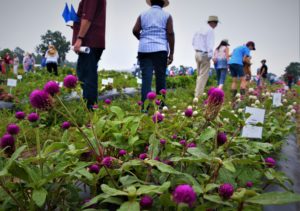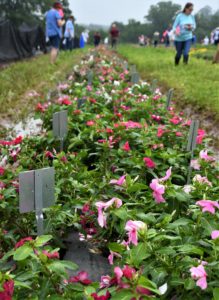East Texas Horticultural Field Day draws flower, vegetable gardeners

OVERTON – Muddy conditions didn’t deter amateur gardener Janice Harper of Dibol from viewing hundreds of ornamental and vegetable varieties during the 26th annual East Texas Horticultural Field Day at the Texas A&M AgriLife Research Bruce McMillan Jr. Foundation East Farm.

Harper, who has attended several of the events, was among almost 300 attendees who braved the less-than-ideal conditions at the annual showcase for ornamental plants and vegetables.
“A little mud doesn’t bother me,” she said. “(The flowers) aren’t in the best shape that I’ve seen, but the ones that are handling all the rain we’ve had this year look spectacular.”
Dr. Brent Pemberton, AgriLife Research ornamental horticulturist in Overton, said weather played a big part in the field trials’ progress up to the event, but that every year can pose different challenges.
“That’s just part of being a gardener,” he said. “Usually we’re dealing with drought, so from a research perspective, this will be an interesting data year on the other end of the spectrum.”

Pemberton started the field trials and field day in 1993 to meet the needs of commercial seed companies, local nursery managers and gardening enthusiasts who wanted more information about how varieties performed in the region. The field day has become an opportunity to showcase plants and educate the public about the conditions under which they perform best.
Pemberton said the field day included varieties that have been popular for years, but also gave attendees a glimpse of bedding plants not yet available to the public.
Above average spring rainfall delayed planting at the East Farm until mid-May this year, and continuous rainfall put a damper on many varieties’ progress, Pemberton said. But overall, the attendance and appreciation of varieties performing well was on par for past years.
“The field trials were young, but it seemed like a good turnout, and all the feedback was very positive,” he said. “Many people were commenting that it would be interesting to see how the varieties are performing later into the summer. But there were several varieties, for instance the coleus, that were showstoppers this year.”
Pemberton said the vincas grew very well, and that the petunias were performing notably well due to the milder weather this June. The demonstration garden behind the center facility was planted earlier and progressed further than varieties in the field trial.
“You can see a marked difference (at the demonstration garden), and there were around 150 varieties there, with more than 350 varieties in the field trial. There was plenty to admire and enjoy.”

Dr. Charles Long, AgriLife center director, said the event was a success despite weather-related issues. Long said the annual event always draws a mix of professionals and amateurs who are interested in and appreciate horticulture, specifically ornamental bedding plants, whether conditions are rain or shine.
Long joined other staff in shuttling attendees to the East Farm due to soggy field conditions.
“We appreciate all the attendees traveling to participate in the field day and to view our trial gardens,” he said. “I was very happy to see those who attended enjoyed the event and visited with us.”


